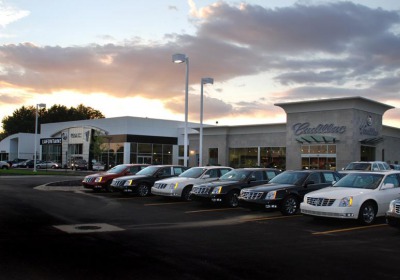U.S. sales, aided by General Motors, show some real spark in October
Wed, 04 Nov 2009U.S. light-vehicle sales--bolstered by General Motor Co.'s first gain in 21 months--declined less than 1 percent in October as the industry showed signs of a recovery without the aid of government incentives.
The drop was the smallest this year and made October the year's strongest month aside from August, which received a lift from the federal cash-for-clunkers program. The seasonally adjusted annual sales rate was 11.2 million. The rate had not risen above 9.9 million this year without clunkers help.
“Numbers in that range certainly are not, by historic standards, good numbers. But thinking of where we've come from, it's certainly a positive signal,” said Jeff Schuster, executive director of global forecasting at the market research firm J.D. Power and Associates. “We're through the worst, and we're beginning the slow trek to recovery.”
Gains from most of the biggest automakers propelled sales to within 216 units of October 2008's total.
GM's U.S. sales rose 5 percent last month--the automaker's first advance since January 2008. Ford Motor Co. grew 3 percent.
Among Asian automakers, Nissan North America climbed 6 percent, Toyota Motor Sales gained less than 1 percent and Hyundai-Kia soared 47 percent. Subaru, Daimler AG, Volkswagen Group and Porsche all were up.
Chrysler Group, meanwhile, plunged 30 percent as it continued to struggle after its bankruptcy. Mazda and American Honda also declined. Suzuki fell 50 percent, while BMW Group trailed year-earlier sales by 19 percent.
The results show automakers benefiting from year-earlier comparisons, after the collapse of Lehman Brothers last October sent the U.S. economy into a deeper tailspin. Industry sales fell 32 percent in October 2008, dragging the seasonally adjusted annual sales rate below 11 million for the first time since 1983.
Industrywide sales remained stuck at 27-year lows this year until the federal government's clunkers incentive pushed demand to rates of 11.1 million units in July and 13.7 million in August. Without the clunkers benefit, September's sales rate dropped to 9.5 million units.
Ford's report of a year-over-year sales gain, its third in the past four months, came a day after the automaker posted a surprise $997 million net profit in the third quarter and its first operating profit in North America since the beginning of 2005.
Sales of the freshly redesigned Ford Taurus sedan more than doubled, while deliveries of the car to individual customers almost tripled from year-earlier levels.
Other automakers
Subaru gained 41 percent in October. Its sales have now risen 13 percent from 2008 levels--the biggest increase among the few companies that have advanced this year.
Hyundai-Kia is also up for the year, reporting a 5 percent increase.
Volkswagen's results included a 1 percent slip from its Audi brand compared with a year earlier, when the brand set a record for October sales. Audi's Q5 crossover, introduced in February, sold 1,238 units last month or 17 percent of the brand's total.
Last month's GM gain compares with October 2008, when demand fell 45 percent, the most among the top six automakers.
“We're not going to declare victory here today, but we're making progress,” said Susan Docherty, GM's vice president of U.S. sales, on a call with journalists and analysts.
Despite the sales gain and a 0.9 percent year-over-year increase in market share, GM said it had decreased its fourth-quarter North American production forecast by 35,000 units to 620,000. That's 24 percent fewer than the automaker built last year.
The reduction mostly accounts for the loss of Saturn production, said Mike DiGiovanni, GM's executive director of global market and industry analysis. GM had not adjusted its forecast after Penske Automotive Group Inc. in September backed out of its deal to buy the Saturn brand and initially fill it with vehicles GM produced.
GM's “truck month” incentives helped push the company's light-truck sales up 18 percent. Because of its success, Docherty said, GM is extending the program through Jan. 4.
Chrysler's 30 percent decline comes on the heels of a 35 percent drop the previous October. The Dodge Avenger sedan and Caravan minivan were Chrysler's only vehicles to post year-over-year sales increases.
Bottomed out
October's sales indicate that the industry probably bottomed out in the second quarter, said Standard & Poor's equity analyst Efraim Levy.
“Going forward, we should see a fairly steady increase in demand,” he said. “How fast, no one knows, but the trend is there.”
Higher sales will mean higher production, Levy said.
“That helps companies all over the industry,” he said. “Whether you're an automaker, auto supplier or auto retailer, it's good for you.”
The U.S. annual sales rate had averaged 10.2 million units through September, down from 13.2 million last year and 16.2 million in 2007.
Jamie LaReau and Jesse Snyder contributed to this report
By Chrissie Thompson- Automotive News

